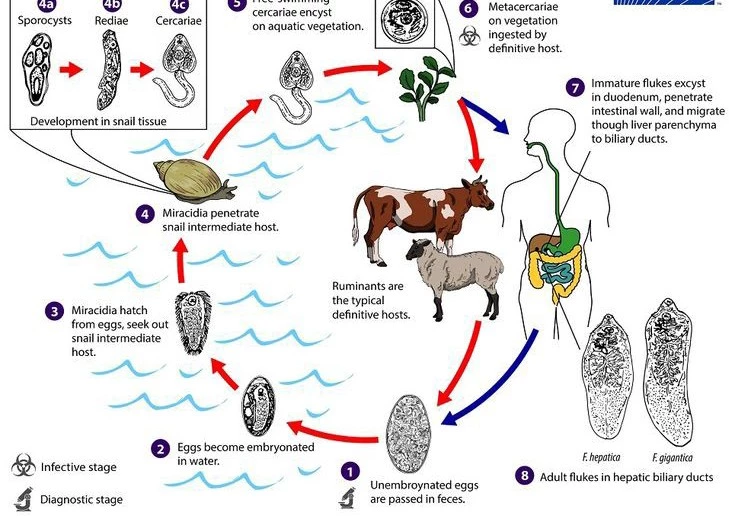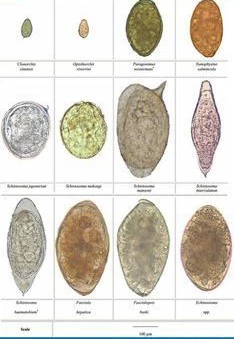Fascioliasis: Life Cycle, Symptoms and Treatment
You may probably be wondering what fascioliasis is, its life cycle, how they affect you, the symptoms that one will see to know that he is she is down with fascioliasis, and finally how it can be treated.
Do not be troubled as this article will meticulously explain all that you need to know about the above concerns and even how you can prevent infestations or re-infestations.
More than 50 countries have fascioliasis, particularly those where sheep or cattle are raised. All continents, except for Antarctica, contain Fasciola hepatica.
Some tropical regions have been discovered to contain Fasciola Gigantica. The majority of cases of human fascioliasis have been reported in poor nations, except for several regions of Western Europe.
In this article, we will be discussing fascioliasis, its causative agents, its life cycle, its notable signs and Symptoms of it, its prevention, and the treatment options for fascioliasis.
Fascioliasis can be prevented and as well treated, but before treatment, a proper diagnosis is necessary.

FASCIOLIASIS AND HOW IT INFEST
Fasciola parasites, flatworms often known as liver flukes, constitute the infectious disease fascioliasis. The bile ducts and liver of infected individuals and animals, including sheep and cattle, contain the adult (mature) flukes.
Fascioliasis is typically more prevalent in livestock and other animals than in humans. People are infected by two Fasciola species (types). Fasciola hepatica sometimes referred to as “the common liver fluke” and “the sheep liver fluke,” is the predominant species. Fasciola Gigantica, a similar species, can also infect humans.
The parasite resides in the bile duct and liver. Herbivorous mammals are among its hosts, and it is present in 46 different species of both domestic and wild animals in addition to people. An intermediate host is a species of snail from the Lymnaea genus, which is found in marshy places and bodies of water. Other species that infect animals with the disease include F. Gigantica and several others.
By unintentionally swallowing the parasite, people become infected. The main cause of this is eating uncooked watercress or other tainted freshwater plants. A person can also become sick by consuming contaminated water, such as by drinking it or by eating vegetables that have been washed or fertilized with it.
In the United States, Fasciola Halli and Fasciola California infect sheep and cattle. These two parasites may be interchangeable with Fasciola Jacksoni, which infects elephants in Africa and India, Fasciola Nyanzae, which infects hippopotamuses, and Fasciola Magna, which primarily infects deer but also infests cattle and sheep.
Direct transmission of fasciola is impossible. The ability to infect someone else depends on the ability of the eggs carried in the feces of infected individuals (and animals) to develop (mature) in specific species of freshwater snails under hospitable environmental conditions.
By consuming undercooked sheep or goat liver that contained immature forms of the parasite, individuals have occasionally contracted the disease.
One of the most economically significant parasite illnesses of livestock is fascioliasis, which affects domestic sheep and other animals throughout Latin America, Africa, Europe, and China. Over 40 million of the 750 million individuals who live in endemic regions are believed to have food-borne trematode infections.
LIFE CYCLE OF FASCIOLIASIS
Eggs, miracidium, cercaria, metacercaria, and adult fluke are the five stages that Fasciola go through in their life cycle.

- When the eggs enter freshwater, they hatch into miracidia. The eggs are passed in the feces of mammalian hosts. Miracidia are free-swimming; they then infect gastropod intermediate hosts and transform into cercariae, and finally
- The cercariae emerge from the host snail and locate and cling to aquatic plants. After that, the cercariae transform into metacercarial cysts.
- When these metacercarial cysts are consumed by a mammalian host along with the aquatic plants, they develop into adult flukes and move to the bile ducts. After consumption, the metacercariae encyst in the duodenum and travel through the peritoneal cavity, liver parenchyma, and the intestinal wall into the biliary ducts, where they mature into adults.
- Adults can remain in mammalian hosts for 5 to 10 years. The vast biliary channels of the mammalian host are where the adult flukes reside. There have also been cases of human infection by eating raw sheep, goats, or cow liver.
SYMPTOMS AND SIGNS OF FASCIOLIASIS
Human fascioliasis is generally recognized as an infection of the bile ducts and liver, but infections in other parts of the body are also recognized. Symptoms are divided into symptoms of acute and chronic phases.
In the early (acute) phase, symptoms may occur as the parasite moves from the intestines to and through the liver. In its severe form, it occurs in sheep but rarely in humans and requires ingestion of large numbers of parasites, often more than 10,000. Occasionally, liver cysts can rupture into the peritoneal cavity, leading to death from peritonitis.
In general, the invasive phase lasts several weeks, with the most common symptoms being intermittent fever, hepatomegaly, and abdominal pain, although up to 50% of infections may be subclinical. Abdominal pain is usually in the right epigastrium or lower abdomen. Other symptoms include irritability and emaciation. Urticaria and eosinophilia are common.
In the chronic phase (after the parasite has implanted in the biliary tract), clinical manifestations may be similar or more subtle, reflecting inflammation and obstruction of the biliary tract, which may be episodic. After reaching the liver, there is a latent period lasting months or even years during which the infection is asymptomatic.
However, with maturity, there may be a period of congestion. Inflammation of the gallbladder and pancreas may also occur; causing hepatitis, cholangitis, or pancreatitis. Fasciola spp. is not suitable for use in humans as the primary host and thus flukes can cause ectopic infections, especially in the lungs and subcutaneous tissue where they can form cysts.

Halzoun is one such action after eating raw liver. There is severe pharyngitis, difficulty swallowing, a sensation of a foreign body in the throat, and possible airway obstruction.
PREVENTIONS OF FASCIOLIASIS
The Fasciola infection cannot be prevented by vaccination. Avoiding raw watercress and other aquatic plants, especially those from endemic grazing areas, is one way that people might protect themselves. As always, visitors to places with inadequate sanitation should stay away from any potentially contaminated food and water.
Specialized control measures are either already in place or are being planned in several regions of the world where fascioliasis is prevalent (endemic). The setting determines the kind of control measures to be used (such as epidemiologic, ecologic, and cultural factors). Watercress and other edible water plants must be grown and sold under strict regulations.
Individuals can protect themselves by not eating raw watercress and other aquatic plants, especially from grazing areas where the liver fluke is present. As always, travelers to areas with poor sanitation should avoid food and drinking water that may be contaminated (contaminated).
Vegetables grown in fields that can be irrigated with contaminated water should be thoroughly cooked, as should the organs of potentially infected animals.
Vegetables grown in water should be washed with 6% vinegar or potassium permanganate for 5-10 minutes to kill fluke larvae. This approach is more effective than trying to stop eating raw vegetables. Thoroughly cook vegetables grown in water before eating.
The use of krillicide is the most common public health intervention, as it prevents the transmission of many other tapeworms, including Schistosoma spp. Animal treatment to reduce wastewater and reduce livestock losses has been used.
Until the introduction of single-dose triclabendazole, bithionol was the only available treatment, very limited by cost and duration of treatment. In the future, vaccination appears to be a viable option.
TREATMENT OF FASCIOLIASIS
Treatment options exist for fascioliasis. Verifying the accuracy of the diagnosis is the first step. Patients should speak with their healthcare physician for more information. Staff from the CDC are available to provide advice to medical professionals on diagnosing and treating fascioliasis.
The preferred medication is triclabendazole. The medication is taken orally, typically in two doses. Most patients respond favourably to the therapy.
Read Also: Helminths (Parasitic Worms) & How They Affect You
CONCLUSIONS
Fasciola parasites, flatworms often known as liver flukes, constitute the infectious disease fascioliasis. Eggs, miracidium, cercaria, metacercaria, and adult fluke are the five stages that Fasciola go through in their life cycle.
Human fascioliasis is generally recognized as an infection of the bile ducts and liver, but infections in other parts of the body are also recognized.
Symptoms are divided into symptoms of acute and chronic phases. And fascioliasis can be treated and prevented as well.






